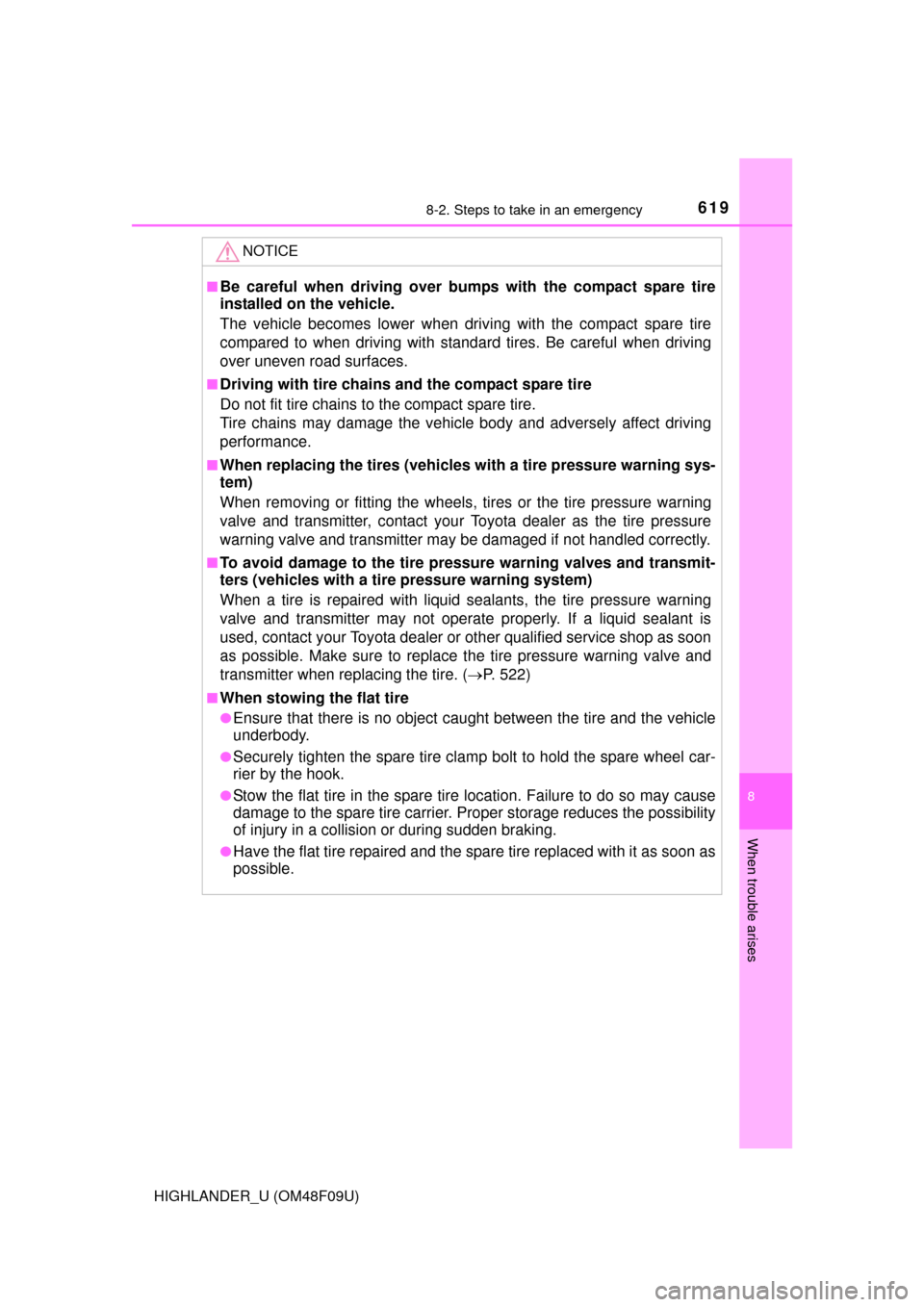Page 619 of 716

6198-2. Steps to take in an emergency
8
When trouble arises
HIGHLANDER_U (OM48F09U)
NOTICE
■Be careful when driving over bumps with the compact spare tire
installed on the vehicle.
The vehicle becomes lower when driving with the compact spare tire
compared to when driving with standard tires. Be careful when driving
over uneven road surfaces.
■Driving with tire chains and the compact spare tire
Do not fit tire chains to the compact spare tire.
Tire chains may damage the vehicle body and adversely affect driving
performance.
■When replacing the tires (vehicles with a tire pressure warning sys-
tem)
When removing or fitting the wheels, tires or the tire pressure warning
valve and transmitter, contact your Toyota dealer as the tire pressure
warning valve and transmitter may be damaged if not handled correctly.
■To avoid damage to the tire pressure warning valves and transmit-
ters (vehicles with a tire pressure warning system)
When a tire is repaired with liquid sealants, the tire pressure warning
valve and transmitter may not operate properly. If a liquid sealant is
used, contact your Toyota dealer or other qualified service shop as soon
as possible. Make sure to replace the tire pressure warning valve and
transmitter when replacing the tire. ( P. 522)
■When stowing the flat tire
●Ensure that there is no object caug ht between the tire and the vehicle
underbody.
●Securely tighten the spare tire clamp bolt to hold the spare wheel car-
rier by the hook.
●Stow the flat tire in the spare tire location. Failure to do so may cause
damage to the spare tire carrier. Proper storage reduces the possibility
of injury in a collision or during sudden braking.
●Have the flat tire repaired and the spare tire replaced with it as soon as
possible.
Page 648 of 716

6489-1. Specifications
HIGHLANDER_U (OM48F09U)
Ty p e A
Ty p e B
Ty p e C
Tires and wheels
Tire size245/60R18 105T, T165/90D18 107M (spare)
Tire inflation pres-
sure
(Recommended
cold tire inflation
pressure)Front35 psi (240 kPa, 2.4 kgf/cm2 or bar)
Rear 35 psi (240 kPa, 2.4 kgf/cm
2 or bar)
Spa re 60 psi (420 kPa, 4.2 kgf/cm
2 or bar)
Wheel size18 7 1/2 J, 18 4T (spare)
Wheel nut torque76 ft•lbf (103 N•m, 10.5 kgf•m)
Tire sizeP245/60R18 104T, T165/90D18 107M (spare)
Tire inflation pres-
sure
(Recommended
cold tire inflation
pressure)Front
35 psi (240 kPa, 2.4 kgf/cm2 or bar)
Rear 35 psi (240 kPa, 2.4 kgf/cm
2 or bar)
Spa re 60 psi (420 kPa, 4.2 kgf/cm
2 or bar)
Wheel size18 7 1/2 J, 18 4T (spare)
Wheel nut torque76 ft•lbf (103 N•m, 10.5 kgf•m)
Tire size245/55R19 103T, T165/90D18 107M (spare)
Tire inflation pres-
sure
(Recommended
cold tire inflation
pressure)Front
35 psi (240 kPa, 2.4 kgf/cm2 or bar)
Rear 35 psi (240 kPa, 2.4 kgf/cm
2 or bar)
Spa re 60 psi (420 kPa, 4.2 kgf/cm
2 or bar)
Wheel size19 7 1/2 J, 18 4T (spare)
Wheel nut torque76 ft•lbf (103 N•m, 10.5 kgf•m)
Page 649 of 716
6499-1. Specifications
9
Vehicle specifications
HIGHLANDER_U (OM48F09U)
Ty p e D
Ty p e E
Ty p e F
Tire size245/60R18 105T
Tire inflation pres-
sure
(Recommended
cold tire inflation
pressure)Front35 psi (240 kPa, 2.4 kgf/cm2 or bar)
Rear 35 psi (240 kPa, 2.4 kgf/cm
2 or bar)
Spa re 35 psi (240 kPa, 2.4 kgf/cm
2 or bar)
Wheel size18 7 1/2 J
Wheel nut torque76 ft•lbf (103 N•m, 10.5 kgf•m)
Tire sizeP245/60R18 104T
Tire inflation pres-
sure
(Recommended
cold tire inflation
pressure)Front
35 psi (240 kPa, 2.4 kgf/cm2 or bar)
Rear 35 psi (240 kPa, 2.4 kgf/cm
2 or bar)
Spa re 35 psi (240 kPa, 2.4 kgf/cm
2 or bar)
Wheel size18 7 1/2 J
Wheel nut torque76 ft•lbf (103 N•m, 10.5 kgf•m)
Tire size245/55R19 103T
Tire inflation pres-
sure
(Recommended
cold tire inflation
pressure)Front
35 psi (240 kPa, 2.4 kgf/cm2 or bar)
Rear 35 psi (240 kPa, 2.4 kgf/cm
2 or bar)
Spa re 35 psi (240 kPa, 2.4 kgf/cm
2 or bar)
Wheel size19 7 1/2 J
Wheel nut torque76 ft•lbf (103 N•m, 10.5 kgf•m)
Page 650 of 716
6509-1. Specifications
HIGHLANDER_U (OM48F09U)
■When towing a trailer (245/55R19 103T tires)
On rear tires, add 1 psi (10.0 kPa, 0.1 kgf/cm
2 or bar) to the recom-
mended tire inflation pressure and drive at speeds below 65 mph (104
km/h).
Page 656 of 716

6569-1. Specifications
HIGHLANDER_U (OM48F09U)
Tire size ( P. 658)
DOT and Tire Identification Number (TIN) ( P. 657)
Location of treadwear indicators ( P. 520)
Tire ply composition and materials
Plies are layers of rubber-coated parallel cords. Cords are the strands
which form the plies in a tire.
Radial tires or bias-ply tires
A radial tire has “RADIAL” on the sidewall. A tire not marked “RADIAL”
is a bias-ply tire.
TUBELESS or TUBE TYPE
A tubeless tire does not have a tube and air is directly put into the tire.
A tube type tire has a tube inside the tire and the tube maintains the air
pressure.
Load limit at maximum cold tire inflation pressure ( P. 662)
Maximum cold tire inflation pressure ( P. 662)
This means the pressure to which a tire may be inflated.
Uniform tire quality grading
For details, see “Uniform Tire Quality Grading” that follows.
Summer tires or all season tires ( P. 525)
An all season tire has “M+S” on the sidewall. A tire not marked “M+S”
is a summer tire.
“TEMPORARY USE ONLY”
A compact spare tire is identified by the phrase “TEMPORARY USE
ONLY” molded on its sidewall. This tire is designed for temporary
emergency use only.
1
2
3
4
5
6
7
8
9
10
11
Page 661 of 716

6619-1. Specifications
9
Vehicle specifications
HIGHLANDER_U (OM48F09U)■
Temperature A, B, C
The temperature grades are A (the hi
ghest), B, and C, representing
the tire’s resistance to the generation of heat and its ability to dissi-
pate heat when tested under cont rolled conditions on a specified
indoor laboratory test wheel.
Sustained high temperature can cause the material of the tire to
degenerate and reduce tire life, and excessive temperature can lead
to sudden tire failure.
Grade C corresponds to a level of performance which all passenger
car tires must meet under the Federal Motor Vehicle Safety Stan-
dard No. 109.
Grades B and A represent higher le vels of performance on the labo-
ratory test wheel than the minimum required by law.
Warning: The temperature grades of a tire assume that it is properly
inflated and not overloaded.
Excessive speed, underinflation, or excessive loading, either sepa-
rately or in combination, can cause heat buildup and possible tire
failure.
Page 662 of 716

6629-1. Specifications
HIGHLANDER_U (OM48F09U)
Glossary of tire terminology
Tire related termMeaning
Cold tire inflation pres-
sure
Tire pressure when the vehicle has been
parked for three hours or more, or has not
been driven more than 1 mile or 1.5 km under
that condition
Maximum inflation
pressureThe maximum cold inflated pressure to which
a tire may be inflated, shown on the sidewall
of the tire
Recommended infla-
tion pressureCold tire inflation pressure recommended by a
manufacturer
Accessory weight
The combined weight (in excess of those stan-
dard items which may be replaced) of auto-
matic transmission, power steering, power
brakes, power windows, power seats, radio
and heater, to the extent that these items are
available as factory-installed equipment
(whether installed or not)
Curb weight
The weight of a motor vehicle with standard
equipment, including the maximum capacity of
fuel, oil and coolant, and if so equipped, air
conditioning and additional weight optional
engine
Maximum loaded vehi-
cle weight
The sum of:
(a) Curb weight
(b) Accessory weight
(c) Vehicle capacity weight
(d) Production options weight
Normal occupant
weight150 lb. (68 kg) times the number of occupants
specified in the second column of Table 1
*
that follows
Occupant distributionDistribution of occupants in a vehicle as speci-
fied in the third column of Table 1
* below
Page 663 of 716

6639-1. Specifications
9
Vehicle specifications
HIGHLANDER_U (OM48F09U)
Production options
weight
The combined weight of installed regular pro-
duction options weighing over 5 lb. (2.3 kg) in
excess of the standard items which they
replace, not previously considered in curb
weight or accessory weight, including heavy
duty brakes, ride levelers, roof rack, heavy
duty battery, and special trim
Rim
A metal support for a tire or a tire and tube
assembly upon which the tire beads are
seated
Rim diameter
(Wheel diameter)Nominal diameter of the bead seat
Rim size designationRim diameter and width
Rim type designationThe industry manufacturer’s designation for a
rim by style or code
Rim widthNominal distance between rim flanges
Vehicle capacity
weight (Total load
capacity)The rated cargo and luggage load plus 150 lb.
(68 kg) times the vehicle’s designated seating
capacity
Vehicle maximum load
on the tire
The load on an individual tire that is deter-
mined by distributing to each axle its share of
the maximum loaded vehicle weight, and
dividing by two
Vehicle normal load on
the tire
The load on an individual tire that is deter-
mined by distributing to each axle its share of
curb weight, accessory weight, and normal
occupant weight (distributed in accordance
with Table 1
* below), and dividing by two
Weather sideThe surface area of the rim not covered by the
inflated tire
Bead
The part of the tire that is made of steel wires,
wrapped or reinforced by ply cords and that is
shaped to fit the rim
Bead separationA breakdown of the bond between compo-
nents in the bead
Tire related termMeaning